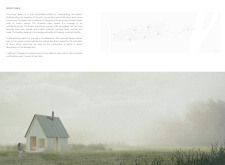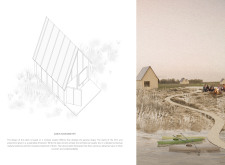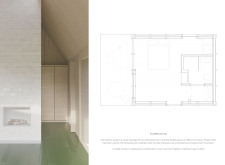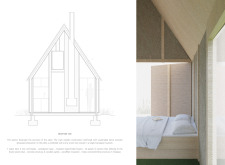5 key facts about this project
The Green Cabin is situated in a subtropical landscape, carefully considering its surroundings while focusing on functionality and sustainability. Designed as a living space, the cabin connects traditional architectural forms with modern practices. This creates a structure that reflects the cultural essence of the area. The concept aims to integrate human living with agricultural activities, particularly through the growth of hemp, highlighting a relationship between the building and the landscape.
Design Concept
The cabin takes on a familiar house shape, featuring traditional proportions, wooden walls, and a gabled roof. These features tie the building to local architectural customs while allowing for a contemporary reinterpretation of classic designs. The overall intent is to harmonize with the natural setting while also establishing a unique presence.
Spatial Organization
The interior layout is uncomplicated, marked by functional areas that promote both comfort and interaction. The open living space works in tandem with private nooks for a kitchenette and wardrobe, allowing a mix of shared and personal areas. This arrangement enhances the overall experience, facilitating movement and socializing while ensuring privacy when necessary.
Materiality
Sustainable materials play an important role in the cabin's construction, particularly hemp concrete, which is made on-site. This element demonstrates a focus on reducing environmental footprints during building. Additionally, wooden panels, ceramic tiles, and a ventilated roof contribute to the cabin’s strength and energy efficiency, creating a structure that is friendly to both the planet and its residents.
Structural Details
Examining the cabin reveals careful attention to detail, where the primary wooden structure interacts with chosen materials to form a coherent unit. Features like an integrated water tank enhance the cabin's independence and efficient resource management. Each design aspect is intentionally developed, resulting in a functional and welcoming space, characterized by a warm core that encourages the enjoyment of light and spatial connections.






















































